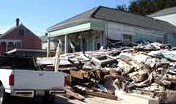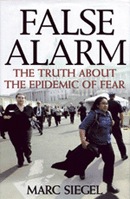| Members of the 42nd Military Police Company of the New York National Guard remember the place in Iraq where they were stationed as a hellhole. “The place was filthy; most of the windows were broken; dirt, grease, and bird droppings were everywhere,” Sergeant Agustin Matos later recalled. “I wouldn’t house a city prisoner in that place.” There were also the frequent sandstorms, blowing dust right into the area where Matos and his fellow company members were based. Sergeant Hector Vega, a retired postal worker from the Bronx who had served in the National Guard for 27 years, said the smoke “was so thick, you could see it.”
Both Matos and Vega survived the war and returned to the US, but all hasn’t been well since then. They and other members of their company now suffer from a variety of maladies: nausea, dizziness, shortness of breath, fatigue, joint pain, and excessive urination, for starters.
The soldiers repeatedly asked to be tested, but the army refused. Eventually, they contacted the New York Daily News with their story. Early this year, the newspaper asked Dr. Asaf Durakovic, a former Army doctor and medical expert, to conduct laboratory tests. His conclusion: four soldiers “almost certainly” inhaled radioactive dust from exploded US shells manufactured with depleted uranium (DU).
The investigation caught the attention of Sen. Hillary Clinton, who chastised the US Defense Department for not screening soldiers returning from duty in Iraq. “We can’t have people coming back with undiagnosed illnesses,” she said. “We have to have before and after testing programs for the soldiers.” Under fire, the Pentagon reversed its decision and began to test some soldiers from the 42nd who had returned home.
However, it’s already a bit late – and not just for the soldiers of the 42nd. Over at least 13 years, and possibly longer, military personnel from the US and other countries have served in wars where DU was used. An extremely dense metal used in armor penetrating shells and to strengthen tank armor, DU is what’s left after enriched uranium is separated from natural uranium so fuel can be produced for nuclear reactors. Military contractors like to use it because it’s cheap; so cheap, in fact, that governments often make it available for free.
Those who defend its use claim that most of the element’s radioactive qualities have been removed before use. However, mounting evidence suggests that DU can pose serious health risks.
The Campaign Against Depleted Uranium (CADU) reports that 15 countries have DU in their military arsenal. In addition to the US, they include the UK, France, Greece, Israel, Turkey, Russia, Egypt, Bahrain, Thailand, Iraq, Pakistan, Taiwan, Kuwait, and Israel. The US has had DU ammunition since the 1950s, but allegedly didn’t use it until the Gulf War. DU has since been used in Bosnia (1995), Yugoslavia (1999), and Iraq.
Ignored Warnings
In July 2004, RAI, Italy’s national television station, reported that 27-year-old Luca Sepe, a veteran of the Yugoslavian conflict, was the “27th Italian victim” of the DU bombings there. It is estimated that another 267 Balkan veterans from Italy have cancer. At this point, there is no solid proof that Italian soldiers died from exposure to DU. One reason is that, as in the US and other countries using DU, the Italian government has blocked investigation of those illnesses and deaths.
In a report about what it labels “Balkan Syndrome,” the International Coalition to Ban Uranium Weapons (ICBUW) has noted that the “Italian Minister of Defense refuses to give compensation to [the Italian soldiers’] families, let alone to admit that depleted uranium has played a role in these cases. Hardly any information is given to soldiers currently on missions abroad about the risks they are facing, and whoever complains is treated as a traitor and marginalized.”
In the 1991 Gulf War, DU was mainly used against Iraqi forces in the desert. In the recent Iraq War, the Pentagon used its radioactive arsenal in suburban areas. According to Pentagon and UN statistics, the US used between 1100 and 2200 tons of shells containing DU during March and April 2003.
Parts of spent DU shells and DU-contaminated debris can be found today strewn on the streets of Iraq’s urban areas. Contaminated sites have been identified, but many of them have yet to be cleaned up. This has created a potential health hazard for many Iraqis. The ICBUW reports that “to minimize the risk of exposure, foreign troops have been instructed to stay away from potentially contaminated areas as much as possible, or, at least, to wear respiratory protection and gloves when it is necessary to enter such sites.”
In May 2003, Scott Peterson, an Iraq-based staff writer for the Christian Science Monitor, took Geiger counter readings at several sites in Baghdad. His readings in some places registered more than 1000 times the normal radiation levels. Three months later, the Seattle Post Intelligencer newspaper reported elevated radiation levels at six sites located between Basra and Baghdad.
Soon after the war, the expert analysis of the World Health Organization and other leading scientific organizations led to warnings that children who come into contact with DU-contaminated shells faced health risks. Even earlier than that, in February 2003, the scholarly, peer-reviewed Journal of Environmental Radioactivity reported, “Children playing with soil may be identified as the critical population group, with inhalation and/or ingestion of contaminated soil as the critical pathway.”
Studies Disputed & Delayed
For more than a decade, the US military has denied that DU poses any health risks and has even tried to suppress the growing evidence that it’s a toxic killer that should be banned. As Ed Ericson wrote in the May-June 2003 issue of E: The Environmental Magazine, the Pentagon “has cashiered or attempted to discredit its own experts, ignored their advice, impeached scientific research into DU’s health effects and assembled a disinformation campaign to confuse the issue.”
The stonewalling began in 1991, after US and British military forces fired about 350 tons of DU at Iraqi tanks and other targets. After the war, Iraqi doctors began reporting increases in cancer and birth defects rates in southern Iraq. As suspicions deepened that DU may have caused the problems, the Pentagon called the charge unsubstantiated. While Saddam Hussein was still in power, Iraqi medical researchers sought to present their findings at international conferences. They were prevented by the economic embargo.
The US military insists that studies from the Gulf War reveal no long-term problems from DU. Only soldiers who had shrapnel wounds from DU or who were inside tanks shot by DU shells and accidentally breathed radioactive dust were at risk, it claims. This would exclude any of the soldiers from the 42nd who became sick since their Iraq tours. Yet, independent organizations say other studies contradict these assertions. In April 2003, for example, the Royal Society, Britain’s leading scientific organization, said that some soldiers could suffer from “kidney damage and an increased risk of lung cancer,” depending on their level of DU exposure.
The problem is that no thorough studies of DU’s long-term effects have been done. In effect, scientists have just begun to measure how much uranium is actually released when uranium-tipped ammunition hits its targets. Without these studies, the amount of uranium dust to which soldiers are exposed can’t be determined.
In the absence of studies and definitive findings, the US and Britain have avoided the issue, resisting pressure to decontaminate DU affected areas in Iraq and implement a moratorium on its military use. In one of the few modest steps in the right direction, Democratic Rep. Jim McDermott introduced the Depleted Uranium Munitions Study Act of 2003. The bill calls for studies of DU’s health effects, requires the Environmental Protection Agency to identify US sites where DU munitions have been used in test firing, and recommends study of the water, vegetation, and soil at these locations for possible contamination. The bill also requires the cleanup of contaminated areas.
This May, the Depleted Uranium Screening and Testing Act of 2004 was introduced in the House. It would require the Pentagon to identify and test those members of the US armed forces who were exposed to DU during military service. Meanwhile, the US General Accounting Office has undertaken a study of the health of veterans exposed to DU in the 1991 Gulf War, as well as the policies of the Department of Defense and the Department of Veteran Affairs in identifying and treating exposed vets.
Germany, one of the strongest critics of the Iraq War, is sending in a team of environmental experts under the auspices of the UN. The group will evaluate the policies of Saddam Hussein, the UN embargo, and the impact of the two invasions on Iraq’s natural resources. The US and British governments have given their blessing. “That is significant because they will also face some critical questions, such as the impact of using depleted uranium munitions,” Germany’s Environmental Minister Juergen Trittin told the press.
Such initiatives, however, fall short of what is needed. A good start would be to acknowledge that the illnesses and deaths of soldiers and civilians from radioactive poison may fit the definition of a war crime.
Ron Chepesiuk, a Rock Hill, SC-based journalist is the author of The Bullet or the Bribe: Taking Down Colombia’s Cali Drug Cartel.
LINKS:
Nukewatch, the Wisconsin-based environmental and peace action group, provides a comprehensive section on DU, with overview and links to resources and recent articles, at http://www.nukewatch.com. The Low Level Radiation Campaign, at www.llrc.org, features a search engine accessing articles on radiation in Iraq. Important recent writing includes “Radiation in Iraq Equals 250,000 Nagasaki Bombs,” by Bob Nichols, at www.dissidentvoice.org; “Depleted Uranium: The Trojan Horse of Nuclear War,” by Leuren Moret, at http://globalresearch.ca; and Tareq Delwani on Jordan’s potential ban of Iraqi scrap metal due to uranium contamination, at http://www.islamonline.net.
|




.gif)
